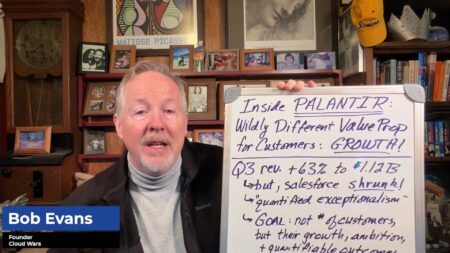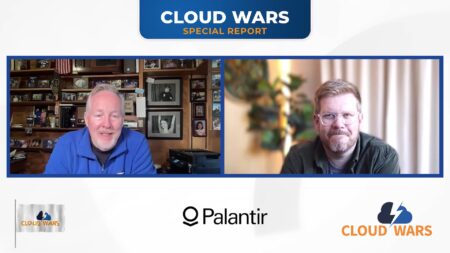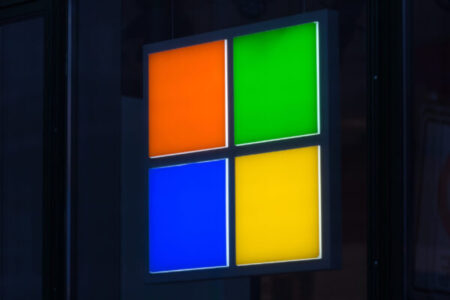Three years ago, if you said infrastructure would be the primary driver in Oracle’s cloud business, you would have been laughed out of town. (On my Cloud Wars Top 10 rankings, Oracle is #6.)
Two years ago, if you had said that Larry Ellison would soon be using world-leading infrastructure technology to snatch huge cloud deals from Amazon and Microsoft and Google, you would have been shunned as disturbingly out of touch with reality.
One year ago, if you’d said Oracle would in late 2020 be one of the hottest cloud-infrastructure players in the world, maybe a few people would have taken you seriously—but they all would have been Oracle employees.
But here today in the waning months of a year that has been more bizarre in a number of ways than any I can recall, Larry Ellison is doing all of those things in real, tangible, and quantifiable ways.
Ellison and Catz: the best is yet to come
And if you’re an Oracle competitor, take note: both Ellison and CEO Safra Catz say that this is barely the beginning of the beginning—and that the best is yet to come. Each of those three IaaS competitors sits well ahead of Oracle on my Cloud Wars Top 10: Microsoft is #1, Amazon/AWS is #2, and Google Cloud is #4.
From Oracle’s Sept. 10 earnings call, here’s Ellison making the case that when it comes to Oracle Cloud, the big dog is OCI—Oracle Cloud Infrastructure—while high-profile Oracle cloud products such as Fusion apps and cloud-native Autonomous Database are simply cogs in the great wheel of Oracle cloud infrastructure.
“We’ve got well over 7,000 Fusion ERP customers, and a lot of those customers are beginning to build data warehouses around their ERP data. Everyone does that. And they’re building those data warehouses using Oracle Autonomous Database and Oracle Analytics and the overall Oracle Cloud using Oracle infrastructure services,” Ellison said in laying out the massive integrated and interconnected opportunity he foresees.
OCI moves to center of Oracle Cloud universe
And Ellison then flipped the script to portray the formerly moribund Oracle infrastructure business as the new engine for Oracle’s growth and relevance.
“The Oracle Analytics Cloud is an Oracle infrastructure service—an OCI service. The Autonomous Database [revenue up 64% in fiscal Q1] is an OCI service.
“So, our application customers—pretty much all of our medium and large application customers—will become, in the not-too-distant future, infrastructure customers.”
And the pie that Ellison’s baking only gets larger from there.
“So these are people that are SaaS customers are going to become infrastructure customers. On-premise database customers are going to become infrastructure customers, either in the form of the public cloud or Cloud@Customer [Oracle cloud services set up within customers’ data centers as private clouds managed by Oracle].
Why pick Oracle over Microsoft, Amazon, Google?
“Then there are the surprises like Zoom and 8×8,” said Ellison in reference to two high-growth video-conferencing businesses that have become significant OCI customers either to handle growth in the case of Zoom or as a new preferred choice over industry leader AWS in the case of 8×8.
“I think Zoom is a great example because it proves that the Oracle Cloud is secure, reliable, high performant and economical. They picked it even though it has nothing to do with the Oracle Database, and it has nothing to do with Zoom being a SaaS customer. That was just purely an evaluation of our cloud versus Microsoft’s versus Google’s versus Amazon’s” (emphasis added).
Warming to the subject of Oracle cloud infrastructure taking business that until several months ago would almost never have come Oracle’s way, Ellison shifted to the car industry.
“And another example of that is high-performance computing with car companies simulating crashes. Now, why would anyone go to the Oracle Cloud to do high-performance computing when you can go to Google or you can go to Microsoft or you can go to AWS? Well, because we’re much faster—we’re much, much faster. And therefore, they get the simulations done faster, but they’ve got to be willing to pay less,” Ellison added, using a favorite line of his to underscore that faster performance results in or should result in lower costs for the customer.
Car companies picking OCI for crash simulations
“Almost every car company—well, maybe that’s too strong. Half the car companies around the world are now either using our high-performance computing or evaluating our high-performance computing because we benchmark so well against the competition.
“And this is all new business, like the video conferencing business.
“So the OCI team did a spectacular job of building a second generation, learning from what Microsoft did, what Google did, what Amazon did and then building the next generation,” Ellison said.
“Again, these are very early days. Gen2 OCI is relatively new, and Gen2 Cloud@Customer is even newer. And these are both fabulous products that I think are going to do extremely well over the next few years.”
I’ll be doing some additional analysis later this week into Oracle’s results and the strategic outlooks and perspectives offered by Ellison and Catz. And while Oracle definitely deserves kudos for its cloud resurgence, and while Ellison is being typically unpredictable in framing this new infrastructure-centric vision for his company, it’s important to bear in mind what he said a moment ago: “These are very early days.”
Objects in Oracle’s rear-view mirror are closer than they appear
They are indeed, and you can bet everything you own and can borrow that Microsoft and Amazon and Google are not standing pat and are not going to allow Oracle to come in and snatch huge chunks of cloud share.
I think that’s why Ellison is flipping the strategic vision for Oracle—he’s resetting the rules of the game to give him and his company the greatest chance for success in this viciously competitive marketplace.
My Scorecard
So I’m scoring this one as a win for Oracle—in fact, a very big win—but also a short-term win. And it’s short-term because Microsoft, Amazon and Google are all much larger than Oracle and are every bit as fiercely committed to innovation and success in the cloud as Oracle is.
Life in the Cloud Wars: if you’re a customer—or if you’re Larry Ellison—you’ve gotta love it!
RECOMMENDED READING
Oracle Q1 Earnings: Why Larry Ellison Will Hammer Amazon, SAP and Workday
The Magic of Marc Benioff: 10 Key Drivers Behind Salesforce Q2 Surge
How Larry Ellison Is Shuffling Top Execs to Spark Next-Gen Oracle Cloud
Larry Ellison’s 3-Point Plan to Beat Amazon: Autonomous, Performance, Security
What Does Larry Ellison Know that Salesforce, ServiceNow & IBM Don’t?
Inside Amazon: 3 Reasons AWS Is No Longer Jeff Bezos’s Growth Engine
Larry Ellison’s Miracle: Oracle Becomes Big-Time Cloud Infrastructure Player
What Did Oracle, Salesforce and SAP All Scrap But Workday Just Revived?
Workday Says Limitations of Legacy Systems (SAP & Oracle) Boosted Q2 Growth
Best Software Acquisition of All Time Was Salesforce Buying Tableau: Marc Benioff
Disclosure: at the time of this writing, Google Cloud was among the many clients of Cloud Wars Media LLC and/or Evans Strategic Communications LLC.
Subscribe to the Cloud Wars Newsletter for in-depth analysis of the major cloud vendors from the perspective of business customers. It’s free, it’s exclusive and it’s great!








